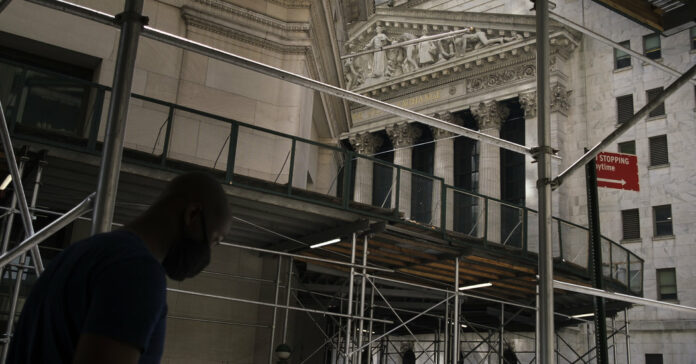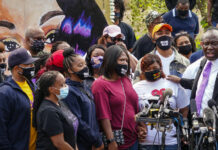Florida, Texas, Oklahoma and South Carolina set daily records. Nationwide, more than 36,000 cases were reported Wednesday.

On Wednesday, governors, mayors, investors and others across the United States woke up to news that was impossible to ignore. More than 35,000 new coronavirus cases had been identified the day before. It was the highest number reported in a single day since late April.
The news kept getting worse. Florida, Texas, Oklahoma and South Carolina reported their highest single-day totals. New York instituted a quarantine for some travelers from out of state. And the stock market slid 2.6 percent as investors fretted about what the latest troubling news meant for economic recovery.
It was as if the country had found itself back in March — at the start of the pandemic, in the early days of the lockdown, when masks were in short supply and the death toll was skyrocketing.
By the end of Wednesday, more than 36,000 new cases had been reported nationwide, the second-highest daily total since the pandemic began.
The new cases showed that the outbreak had been far from contained. That could lead some states to slow the process of reopening businesses, further hobbling the economy and delaying its recovery.
Some states, including New York, which at one point had the most virus cases, have brought the number under control. But cases are still rising in more than 20 states, especially in the South and West.
Florida reported a new daily high of 5,508 cases on Wednesday, and the percentage of residents testing positive has risen sharply. Gov. Gavin Newsom of California said Wednesday that the state recorded more than 7,000 new cases over the past day.
“I want to remind everybody that we are still in the first wave of this pandemic,” Mr. Newsom said during a virtual news briefing. The governor pleaded with residents, many of whom he acknowledged were gathering with friends and relatives, to continue practicing social distancing, to stay outdoors whenever possible and to wear a mask.
Texas reported more than 6,000 new cases on Wednesday. In Houston, the intensive-care units were at 97 percent of capacity, and hospitals risked running out of I.C.U. beds within two weeks if nothing is done to slow the upward trajectory of the virus.
“I strongly feel we are moving in the wrong direction, and we are moving fast,” Mayor Sylvester Turner of Houston said.
In Washington State, where cases are rising again, Gov. Jay Inslee said residents would have to start wearing masks in public.
“This is about saving lives,” Mr. Inslee said. “It’s about reopening our businesses.”
In Florida on Wednesday, Gov. Ron DeSantis gave no indication that the state would roll back its economic opening, but he urged residents to avoid closed spaces with poor ventilation, crowds and close contact with others.
Mr. DeSantis continued to attribute the rising infections to younger people who have started to socialize in bars and homes, despite rules in many municipalities prohibiting group gatherings.
“You need to do your part and make sure that you’re not spreading it to people who are going to be more at risk for this,” he said.
The percentage of people in Florida testing positive has risen sharply, but testing alone does not explain the surge. Increases in hospitalizations also signal the virus’s spread.
New case reports also reached their highest levels in recent days in Missouri, but coronavirus hospitalizations have declined slightly over the last month.
“We are NOT overwhelmed,” Gov. Mike Parson wrote on Twitter, linking the uptick to more testing. “We are NOT currently experiencing a second wave. We have NO intentions of closing Missouri back down at this point in time.”
The World Health Organization warned on Wednesday that if governments and communities in the Americas were not able to stop the spread of the virus through surveillance, isolation of cases and quarantine of contacts, there might be a need to impose — or reimpose — general lockdowns.
The New York quarantine announced by Gov. Andrew M. Cuomo applies to visitors from Alabama, Arizona, Arkansas, Florida, North Carolina, South Carolina, Utah and Texas, as well as New Yorkers returning from those states. Violators could be subject to a mandatory quarantine and fines of up to $10,000. Travelers to New Jersey and Connecticut will also be told to quarantine.
The reopening of many businesses is not going smoothly. Apple said Wednesday that it had shut seven stores in the Houston area because of the rising number of cases in the region. Last week, it closed 11 stores in Arizona, Florida, South Carolina and North Carolina. Apple had opened most of its stores in the United States in recent weeks after closing nearly all of its roughly 500 stores worldwide months ago.
Many stock market investors, who had been expecting the virus to retreat swiftly, were alarmed by its resurgence. The spike appeared to undermine hopes for a V-shaped rebound, in which both the economy and corporate profits would bounce back as swiftly as they plunged when the United States fell into a recession.
“All the hopes of investors looking for a better economy to improve the bottom lines of companies shut down in the recession have been dashed,” Chris Rupkey, chief financial economist at MUFG Union Bank, wrote in a note to clients on Wednesday. “Forget about the fears of the virus coming back in the fall. The number of new cases and hospitalizations in states like Arizona, Texas and Florida says the threat is happening right now.”
This is the second time in recent weeks that the S&P 500 stock market index has faltered. On June 11, reports of rising infections set off a 5.9 percent drop. Wednesday’s market drop was led by sharp downturns in sectors including energy, industrial and financial shares, which tend to be sensitive to the near-term expectations for economic growth.
For most of the day, investors clobbered the stocks of companies that are most vulnerable to the risks of a prolonged pandemic. The cruise line Norwegian was down 12.4 percent, while competitors Royal Caribbean and Carnival both plummeted more than 11 percent. They were the three worst-performing issues in the S&P 500.
Airlines were hammered, with United Airlines down more than 8.3 percent and Delta Air Lines dropping by 7.8 percent. Energy and oil field services companies tumbled, too. Occidental Petroleum dropped 9 percent and Haliburton fell 8.8 percent, as oil prices dropped more than 5 percent pushing the cost of a barrel of West Texas Intermediate oil below $40.
Investors in other markets assumed a dour outlook for economic growth. Yields on government bonds — traditionally linked to expectations for growth and inflation — fell. The dollar, a traditional safe haven for investors, rose.
Gold prices slipped slightly, after earlier in the day flirting with some of their highest levels in almost a decade, approaching $1,780 an ounce. Gold is traditionally viewed as a hedge against potential inflation, and a safe asset for investors during times of growing political and economic uncertainty.
The global picture also looked gloomy. The International Monetary Fund said global gross domestic product would shrink 4.9 percent in 2020, a sharper contraction than the 3 percent decline it predicted just two months ago. The I.M.F. also lowered its expectations for growth in the United States, saying that the world’s largest economy will shrink 8 percent this year, more than the roughly 6 percent rate it expected in April.
“We are definitely not out of the woods,” said Gita Gopinath, director of the I.M.F.’s research department. “This is a crisis like no other and will have a recovery like no other.”
And as infection rates rise in California, the Walt Disney Company on Wednesday abandoned its plan to reopen Disneyland and Disney California Adventure on July 17, citing a slower-than-anticipated approval process by state regulators.
The two theme parks, which border each other in Anaheim, closed on March 13. Unions representing most of the Disneyland’s 32,000 employees sent a letter to Governor Newsom on June 17 saying that “despite intensive talks with the company, we are not yet convinced that it is safe to reopen the parks on Disney’s rapid timetable.” Since then, many of Disney’s unions have signed agreements with the company outlining enhanced safety procedures.
Reporting was contributed by Jack Nicas, Alan Rappeport, J. David Goodman and Brooks Barnes.






